Oaxaca
by Joe Floresauthor, with C Woolworth, of La Ventana, The Window to the Revolutionary Coinage of Oaxaca 1915, 1988 (available in the USMexNA online library)
Introduction
On 3 June 1915 with the Revolution continuing to gain popular support, the Governor of the state of Oaxaca, José Inés Dávila, proclaimed the state a free and sovereign entity and proceeded to withdraw from the Federation of the United States of Mexico.
As in other areas of Mexico, the Revolution had created a severe shortage of coinage. By issuing large amounts of worthless paper money, the gold and silver coins had virtually disappeared. A need for local coinage was quite urgent and the Governor made preparations for opening the old mint that had been closed for over twenty years.
Several men were appointed by the Governor to get the mint in operation. Most important were Teofilo Monroy who was appointed Director of the Minthis initials TM appear on some coins and John De Coe who became the Chief Engraver. De Coe immediately began the task of preparing dies for the large two pesos "balance scale" coin. His method of using a "bust die" and a separate "legend die” to create a "working die" was most responsible for there being so many varieties of the Oaxaca coins.
Inés Dávila, in his decree núm. 2 had authorised the issue of coinage even before his state's secession. On 19 February 1915 he had authorised paper currency in the form of títulos de crédito and bronze or copper coins of one, five and ten centavos and silver coins of twenty and fifty centavos and one peso. On 10 July decree núm. 5 added a two pesos denomination, again in silver. Finally, on 12 January 1916, Inés Dávila, in decree núm. 18, provided for bimetallic coins of siver and copper in the denominations of two and five pesos and copper or bronze coins of three centavos.
Varieties
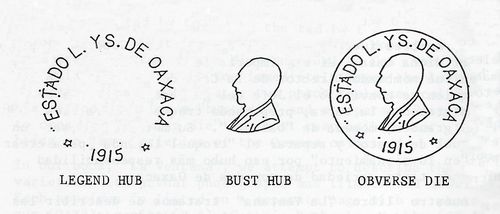
The obverse legend and border was cut on a single hub. The bust was cut on a separate hub (this article distinguishes ten different busts). The dies were produced from these two hubs in two separate operations. As new dies were needed, the bust hub was never placed in exactly the same position therefore the distance between the bust and stars was never exactly the same. Also, finishing touches were made to the completed dies by hand … letters re-engraved, periods added, etc. These two factors resulted in many die varieties.
1c and 3c rectangular coins

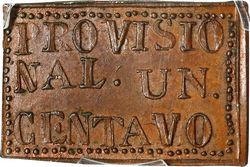
KM-709 1c rectangular (Stack’s Bowers January 2023 NYINC Auction, 19 January 2023, lot 42734)
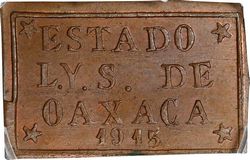

KM-711 3c rectangular (Stack’s Bowers January 2023 NYINC Auction, 13 January 2023, lot 21257)
The rectangular coins of Oaxaca were not a preconceived issue but came about due to the availability of some strips of copper. Three rolls of copper tape were found that could easily be cut into rectangular planchets. All that was needed were rectangular dies small enough to fit the tiny planchets. The dies were probably cut by Teofilo Monroy, the Director of the Mint, since they were the first coins to contain his initials. Even though John De Coe had been appointed chief engraver, he had already begun work on the two pesos balance scale coins.
The rectangular issue was a complete failure. The coins were never accepted as such by the people … sharp edges are not compatible with pockets. According to Sanchez GarzaJosé Sanchez Garza, Historical Notes on Coins of the Mexican Revolution 1913-1917, translated by A. Frank, Mexico City, 1932 (available in the USMexNA online library), there were 500 rectangular coins produced but most were later re-melted. All specimens existing today are quite rare!
Regular series
One & Three Centavos
There were two obverse and two reverse dies used to strike the small one centavo coins. However, there was only one obverse die used with three different reverse dies to strike the three centavos coins. All of the coins in this group are scarce but the three centavos flat - top 3 variety is extremely rare.
Five Centavos
The 5 centavos series contains some extremely rare specimens but most are fairly common. The 5 centavos coins were struck with several obverse dies that used different busts. Many of these same dies also were used to strike the small 50 centavos and 2 pesos coins.
Ten Centavos
There were more coins struck of the 10 centavos series than any other. There were 14 obverse dies and 10 reverse dies used to strike 24 different varieties.
20 Centavos
There are fourteen varieties … not counting the plain edge and counterstamped varieties
50 Centavos
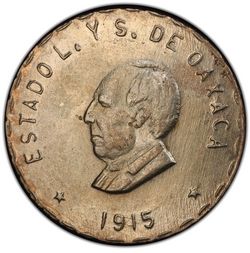
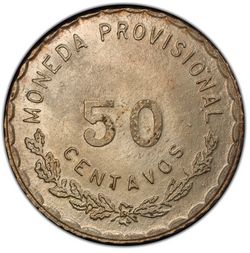
KM-737
Most of the 50 centavos coins are quite rare.
One Peso
Two Pesos-Balance Scale Series
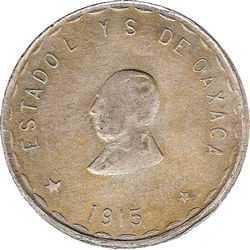
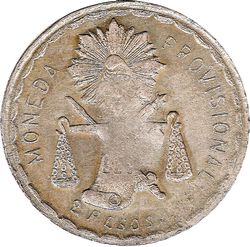
KM-746
There are thirteen varieties included in this series, one of them being an edge variety. The other twelve consist of two basic types. There are eight "Dos Pesos" (note: two new varities are added here) and four "2 Pesos" types.
Most catalogs in the past have listed the 2 Pesos coins before the Dos Pesos but we believe the actual sequence of striking was just the opposite. There are two reasons for our belief. First, one of the Dos Pesos coins seems to be a "true pattern" and second the method of producing the 2 Pesos reverse dies was quite different from the Dos Pesos.
The obverse dies were produced from a single legend hub and a separate bust hub in two separate operations. The reverse dies were created in the same manner. A balance scale hub and a separate legend hub were used to produce the reverse dies.
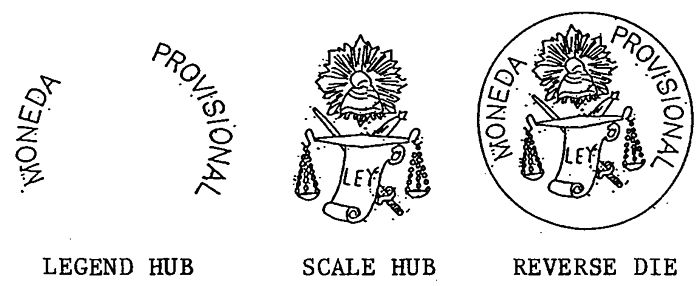
As you can see in the above example, the reverse dies were not yet complete at this stage … there was no "value". The "Dos Pesos" had to be cut into the die by hand. Later when the "Dos Pesos" value was changed to "2 Pesos", the 2 Pesos was included in a new legend hub and hand engraving was no longer necessary.

Two Pesos-Reduced Size
Five Pesos
This is a short series that contains only a few varieties.
Gold Series
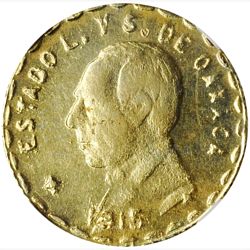

KM-750; GB-372.$5 gold (Stack’s-Bowers ANA Auction, 20 August 2021 , lot 41214)
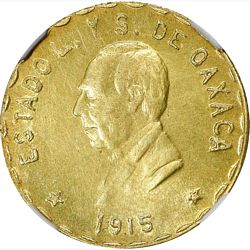

KM-752 $10 gold (Stack’s-Bowers Auction, 16 May 2023, lot 70576)
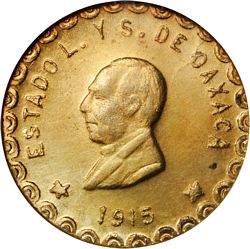

KM-754, GB-377, $20 gold (Stack’s-Bowers Winter 2014 Baltimore Auction , lot 713
The gold coins of Oaxaca are an interesting group. All coins except the 60 Pesos contain very little gold and the specimens we have seen are merely silver cores that are gold-plated. Nevertheless, there were so few specimens struck they are all rare.
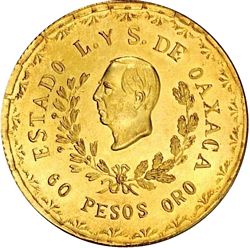
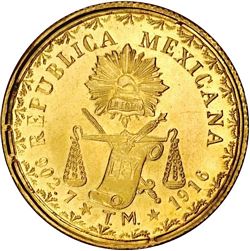
KM-755, GB-379, A-OX-178 $60 gold (Stack’s-Bowers, The Louis E. Eliasberg, Sr. Collection, 15 April 2005, lot 3424)
The 60 pesos coins are a story within themselves. There seems to be more of these coins in existence than there should be but all that we have seen were struck with the original dies but maybe "after the fact".
